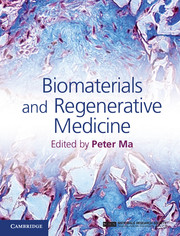Book contents
- Frontmatter
- Contents
- List of contributors
- Preface
- Part I Introduction to stem cells and regenerative medicine
- Part II Porous scaffolds for regenerative medicine
- Part III Hydrogel scaffolds for regenerative medicine
- Part IV Biological factor delivery
- Part V Animal models and clinical applications
- 25 Bone regeneration
- 26 Biomaterials for engineered tendon regeneration
- 27 Advancing articular cartilage repair through tissue engineering: from materials and cells to clinical translation
- 28 Engineering tissue-to-tissue interfaces
- 29 Models of composite bone and soft-tissue limb trauma
- 30 Tooth development and regeneration
- 31 Dentin–pulp tissue engineering and regeneration
- 32 Dental enamel regeneration
- 33 Hair follicle and skin regeneration
- 34 In-vitro blood vessel regeneration
- 35 Stem cells for vascular engineering
- 36 Cardiac tissue regeneration in bioreactors
- 37 Bladder regeneration
- Index
- References
31 - Dentin–pulp tissue engineering and regeneration
from Part V - Animal models and clinical applications
Published online by Cambridge University Press: 05 February 2015
- Frontmatter
- Contents
- List of contributors
- Preface
- Part I Introduction to stem cells and regenerative medicine
- Part II Porous scaffolds for regenerative medicine
- Part III Hydrogel scaffolds for regenerative medicine
- Part IV Biological factor delivery
- Part V Animal models and clinical applications
- 25 Bone regeneration
- 26 Biomaterials for engineered tendon regeneration
- 27 Advancing articular cartilage repair through tissue engineering: from materials and cells to clinical translation
- 28 Engineering tissue-to-tissue interfaces
- 29 Models of composite bone and soft-tissue limb trauma
- 30 Tooth development and regeneration
- 31 Dentin–pulp tissue engineering and regeneration
- 32 Dental enamel regeneration
- 33 Hair follicle and skin regeneration
- 34 In-vitro blood vessel regeneration
- 35 Stem cells for vascular engineering
- 36 Cardiac tissue regeneration in bioreactors
- 37 Bladder regeneration
- Index
- References
Summary
Introduction
The dentin–pulp complex is the principal inner component of the tooth beneath the superficial enamel layer in the tooth crown, and comprises the entire tooth root outlined with a thin cementum layer. The highly mineralized dentin confers structural integrity and insulative properties to the tooth and surrounds the pulp chamber and canals, which confer vitality to the tooth and whose neurovascular supplies exit through constricted foramina at the root apices. The pulp also has reparative mechanisms, activated by insults to the overlying dentin by noxious stimuli such as attrition, trauma, and caries. Together, the dentin–pulp complex plays a crucial role in tooth health.
The aforementioned noxious stimuli may lead to dentinal damage, as well as pulpal inflammation or necrosis. Such external damage to the dentin renders the pulp vulnerable to external invasion if the extent of the insult extends throughout the thickness of the dentin layer in question. Given the pulp’s solely apical blood supply and limited self-healing capacity, recovery from insult to pulp tissue is difficult, and the resulting inflammation is often irreversible. Currently, complete pulpal resection (root canal therapy) is the default treatment for necrosed or irreversibly inflamed pulp of a tooth that is otherwise restorable. Such teeth are restored first by obturating the pulp canals with an inert material, usually Gutta-Percha; then, direct restorative materials (such as silver amalgam or resin-based composites) and/or full-coverage crowns (metal/porcelain/combination) are used to restore the remainder of the tooth. Although these traditional restorative materials and methods have proven to be adequately effective in conserving teeth, they may render the remaining natural tooth structure mechanically compromised [1], and are incapable of repairing the tissue exposed to harmful stimuli [1, 2].
- Type
- Chapter
- Information
- Biomaterials and Regenerative Medicine , pp. 570 - 582Publisher: Cambridge University PressPrint publication year: 2014
References
- 1
- Cited by



